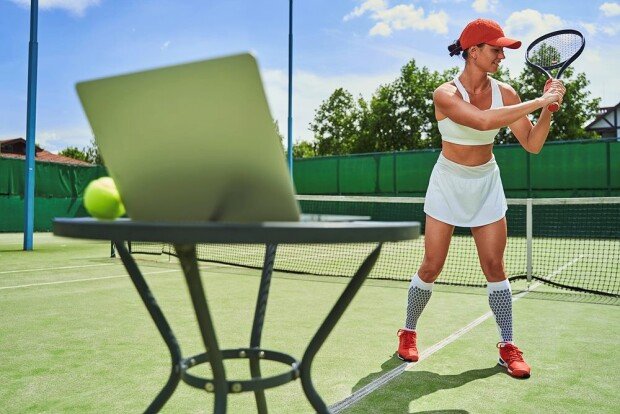Can Autonomous Vehicle Technology Transform Sports?
Can Autonomous Vehicle Technology Transform Sports?
Posted November. 26, 2024 10:53,
Updated November. 26, 2024 14:57
[IT Donga] Following its impact on sports like baseball, Go, and soccer, AI is now making waves in tennis, one of the world’s most popular sports. By recording matches on video and analyzing them with AI, valuable game data can be extracted. Advanced technology now combines optics and autonomous driving systems to enhance convenience while lowering costs.
The sports industry has long been translating data into valuable insights through mathematical analysis. A notable example is "Sabermetrics," popularized by the 2011 movie Moneyball. Major League Baseball (MLB) used statistical data collected over decades, applying mathematical methods to optimize players' performance and develop game strategies.
In 2016, AI took data analysis a step further with the advent of Google DeepMind’s AlphaGo. By analyzing thousands of years of recorded Go games, AlphaGo was able to defeat some of the world’s top players, revolutionizing the game. Today, even elite Go professionals rely on AI to enhance their skills.
 / Source: envato elements
/ Source: envato elements
With the success of standardized data analysis, real-time game tracking and analysis technology has become more widely adopted. Examples include Video Assistant Referees (VAR) in soccer, which determine goal outcomes and offside positions, and Hawk-Eye in tennis, which assesses line calls. Hawk-Eye, in particular, provides top-ranked players with rich, detailed play data after each match.
Despite these advances, real-time game tracking and analysis technologies come with high costs and complex setups. They require multiple cameras and extensive equipment, making them prohibitively expensive and challenging to implement. As a result, this technology has mostly been accessible to top-ranked professional athletes, leaving amateur and lower-ranked players without access to similar tools.
Around 2020, autonomous vehicles and robotics became a major trend in the information and communication technology sector, leading to rapid growth in the hardware and software markets. Amidst this trend, the startup ShotAi drew attention by leveraging high-performance autonomous vehicles and robotics sensor technology to create a new sports tech solution—a data collection and analysis system specifically designed for tennis.
 Source : “Autonomous Vehicle Market Size by Component (Hardware and Software and services), Application (Transportation and Defense), Regions, Global Industry Analysis, Share, Growth, Trends, and Forecast 2023 to 2032”
Source : “Autonomous Vehicle Market Size by Component (Hardware and Software and services), Application (Transportation and Defense), Regions, Global Industry Analysis, Share, Growth, Trends, and Forecast 2023 to 2032”
ShotAi integrates knowledge from autonomous driving, utilizing high-quality camera sensors and hardware. This system operates with a single, portable camera that can be hung on a tennis court fence, adjusting its view autonomously to capture and record games.
The ShotAi system employs an AI-based perception model, utilizing No-LIDAR technology to estimate distances without LIDAR sensors and performing 3D recognition using only an optical camera. This enables a single camera to capture and record the movements of both players and the ball in detail.
The data collected and analyzed by ShotAi is extensive. It tracks not only the positions of serves and strokes but also the ball’s trajectory and speed, player movements, stroke directions, and racket contact points. In addition to recording matches in real-time, the system provides highlight videos.
While some companies previously offered recording and highlight analysis at lower costs than pro-level systems, their services remained expensive (over $10,000) and limited in analytical depth. In contrast, ShotAi offers a more affordable option with greater data granularity, enhancing players' skills and providing insights into opponents’ strategies. Casual users can also enjoy sharing ShotAi’s highlight videos on social media.
ShotAi has completed development and is now targeting the U.S. market, where there are approximately 270,000 tennis courts and a large tennis-playing population. Among these are junior players aspiring to reach college or professional levels.
ShotAi initially plans to offer its technology to junior and high-level amateur players at a more accessible price, enabling them to benefit from this advanced data analysis system.
As more junior and amateur players use the system, ShotAi will accumulate vast amounts of match and training data to continually improve its AI model. Reflecting real-world match data, the company aims to increase the system’s accuracy and secure certification from the International Tennis Federation (ITF) and the Association of Tennis Professionals (ATP). Building on this success, ShotAi envisions expanding its consumer base to include tour-level players.
 / Source: ShotAI
/ Source: ShotAI
‘Sports like baseball and Go have long used structured data to develop strategies and training methods, as their characteristics make data collection straightforward," said CEO Brock Noh. ‘With ShotAi, the same is possible for tennis through an affordable solution. Imagine if Roger Federer’s play data and growth milestones had been recorded from his early years—junior players today could gain invaluable insights from it. ShotAi aims to make recording technology more accessible for racket sports, supporting both the industry and the growth of junior players.’
Cha Ju-Kyung (racingcar@itdonga.com)
The sports industry has long been translating data into valuable insights through mathematical analysis. A notable example is "Sabermetrics," popularized by the 2011 movie Moneyball. Major League Baseball (MLB) used statistical data collected over decades, applying mathematical methods to optimize players' performance and develop game strategies.
In 2016, AI took data analysis a step further with the advent of Google DeepMind’s AlphaGo. By analyzing thousands of years of recorded Go games, AlphaGo was able to defeat some of the world’s top players, revolutionizing the game. Today, even elite Go professionals rely on AI to enhance their skills.

With the success of standardized data analysis, real-time game tracking and analysis technology has become more widely adopted. Examples include Video Assistant Referees (VAR) in soccer, which determine goal outcomes and offside positions, and Hawk-Eye in tennis, which assesses line calls. Hawk-Eye, in particular, provides top-ranked players with rich, detailed play data after each match.
Despite these advances, real-time game tracking and analysis technologies come with high costs and complex setups. They require multiple cameras and extensive equipment, making them prohibitively expensive and challenging to implement. As a result, this technology has mostly been accessible to top-ranked professional athletes, leaving amateur and lower-ranked players without access to similar tools.
Around 2020, autonomous vehicles and robotics became a major trend in the information and communication technology sector, leading to rapid growth in the hardware and software markets. Amidst this trend, the startup ShotAi drew attention by leveraging high-performance autonomous vehicles and robotics sensor technology to create a new sports tech solution—a data collection and analysis system specifically designed for tennis.

ShotAi integrates knowledge from autonomous driving, utilizing high-quality camera sensors and hardware. This system operates with a single, portable camera that can be hung on a tennis court fence, adjusting its view autonomously to capture and record games.
The ShotAi system employs an AI-based perception model, utilizing No-LIDAR technology to estimate distances without LIDAR sensors and performing 3D recognition using only an optical camera. This enables a single camera to capture and record the movements of both players and the ball in detail.
The data collected and analyzed by ShotAi is extensive. It tracks not only the positions of serves and strokes but also the ball’s trajectory and speed, player movements, stroke directions, and racket contact points. In addition to recording matches in real-time, the system provides highlight videos.
While some companies previously offered recording and highlight analysis at lower costs than pro-level systems, their services remained expensive (over $10,000) and limited in analytical depth. In contrast, ShotAi offers a more affordable option with greater data granularity, enhancing players' skills and providing insights into opponents’ strategies. Casual users can also enjoy sharing ShotAi’s highlight videos on social media.
ShotAi has completed development and is now targeting the U.S. market, where there are approximately 270,000 tennis courts and a large tennis-playing population. Among these are junior players aspiring to reach college or professional levels.
ShotAi initially plans to offer its technology to junior and high-level amateur players at a more accessible price, enabling them to benefit from this advanced data analysis system.
As more junior and amateur players use the system, ShotAi will accumulate vast amounts of match and training data to continually improve its AI model. Reflecting real-world match data, the company aims to increase the system’s accuracy and secure certification from the International Tennis Federation (ITF) and the Association of Tennis Professionals (ATP). Building on this success, ShotAi envisions expanding its consumer base to include tour-level players.

‘Sports like baseball and Go have long used structured data to develop strategies and training methods, as their characteristics make data collection straightforward," said CEO Brock Noh. ‘With ShotAi, the same is possible for tennis through an affordable solution. Imagine if Roger Federer’s play data and growth milestones had been recorded from his early years—junior players today could gain invaluable insights from it. ShotAi aims to make recording technology more accessible for racket sports, supporting both the industry and the growth of junior players.’
Cha Ju-Kyung (racingcar@itdonga.com)
Headline News
- Lee acquitted of subornation of perjury charges in first trial
- Trump’s second term to pressure S. Korea to join China export controls
- 25 cases of technology theft to overseas caught this year
- Russia warns S. Korea over supplying lethal weapons to Ukraine
- Lee Jae-sung scores header goals in consecutive Bundesliga matches







